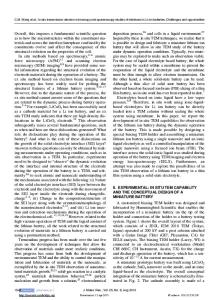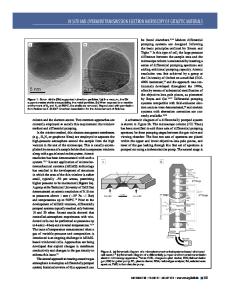In situ transmission electron microscopy ion irradiation studies at Orsay
- PDF / 2,616,849 Bytes
- 11 Pages / 612 x 792 pts (letter) Page_size
- 53 Downloads / 496 Views
A. Borodin Russian Research Center Kurchatov Institute, 123 182 Moscow, Russia (Received 18 November 2004; accepted 14 February 2005)
Crucial features of materials evolution due to ion beam irradiation are often revealed only through studies of process dynamics. We review some significant examples of such experiments performed over the last 25 years with the Orsay in situ facility: a transmission electron microscope setup (with temperature stages operating between 4 and 1000 K) on a medium energy (3–570 keV) ion beam line. New results on nanocavity evolution and metal silicide nanoprecipitates in Si are presented briefly. We show that CoSi2 nanoprecipitate growth is mainly due to the constant Co atom contribution from the ion beam, and CoSi2 platelet growth is the result of a three-dimensional to two-dimensional growth mode transition.
I. CSNSM–ORSAY IN SITU TRANSMISSION ELECTRON MICROSCOPY FACILITY
The initial setup was a 100 keV transmission electron microscope (TEM; EM400 Philips, Eindhoven, The Netherlands) installed on a beamline of the home-built ion implanter IRMA in 1980. This was based on the experience gained by the Orsay–Toulouse collaboration with the first setup of this kind, built in 1976.1 In1994, the Orsay TEM was replaced by a 120 keV CM12 Philips version (Fig. 1). IRMA is a relatively high-current (1 mA total), medium energy ion implanter involving (i) a small, electrically isolated 30 kV isotope separator with a quasi-universal positive ion source2 (Bernas–Nier Type); and (ii) 150 kV post-acceleration, refocusing, and beam rastering on samples for homogeneous implantation or irradiation. Ion beams of nearly 80 elements have been produced. The IRMA connection to the TEM allows in situ TEM observations during sample implantation or irradiation at energies ranging from 5 to 570 keV (the maximum beam energy compatible with observation depending on the ion mass for ion beam steering reasons). Our present TEM has a resolution of 0.37 nm. Although this is far from the best obtainable today, it is a reasonable compromise for in-beam experiments where resolution is limited by beam line vibrations. These are minimized in the present setup by appropriate bellows on the beam line extremities (Fig. 2). To be accurate, ion beam intensity measurements have
DOI: 10.1557/JMR.2005.0219 1758
http://journals.cambridge.org
J. Mater. Res., Vol. 20, No. 7, Jul 2005 Downloaded: 19 Mar 2015
to be done as close as possible to the sample. This is a crucial point. We have developed a Faraday-cup which is fitted 3 cm upstream from the sample, providing beam flux measurement accuracy better than 10% (Fig. 3). This setup is compatible with beam rastering over an area of 2 cm2, leading to uniform sample irradiation or implantation. Using a single-tilt sample holder working at angles up to 30–40° off the horizontal plane,3 this allows studies of in-beam structural evolution for samples which do not require special crystallographic orientation, in a temperature range between 15 and 1000 K. A double-tilt sample holder obvious
Data Loading...











